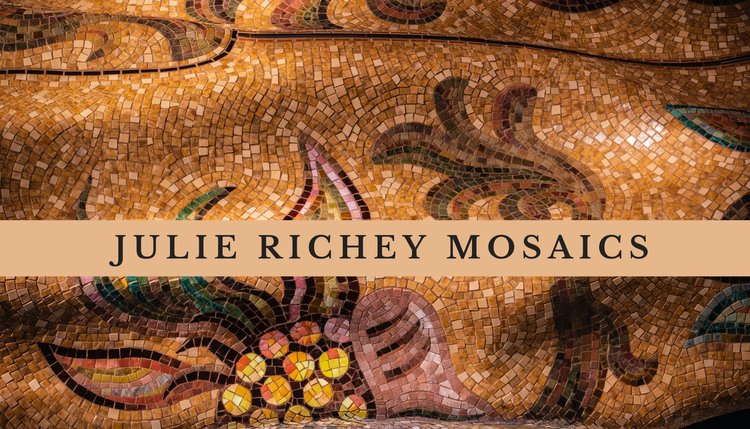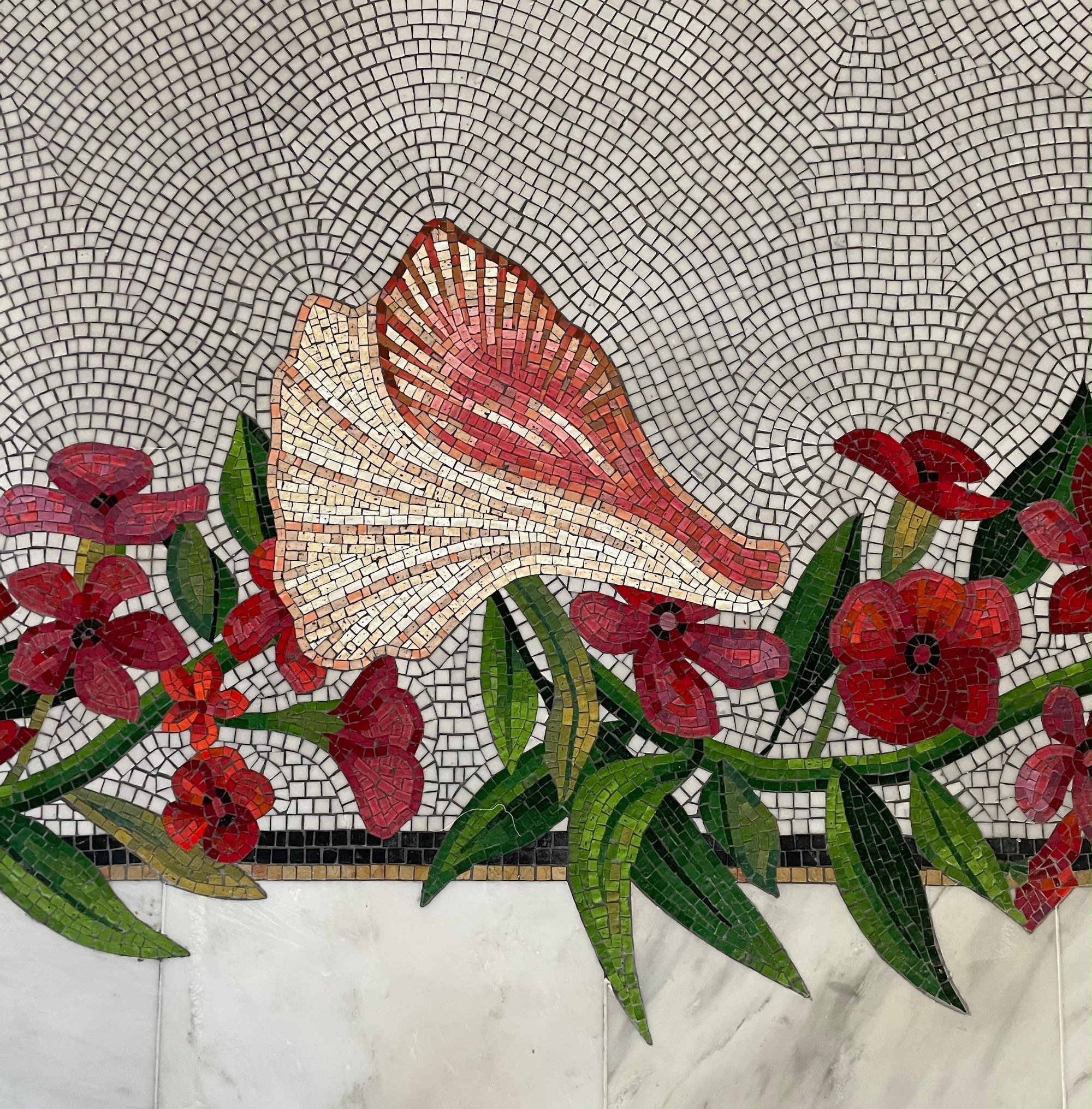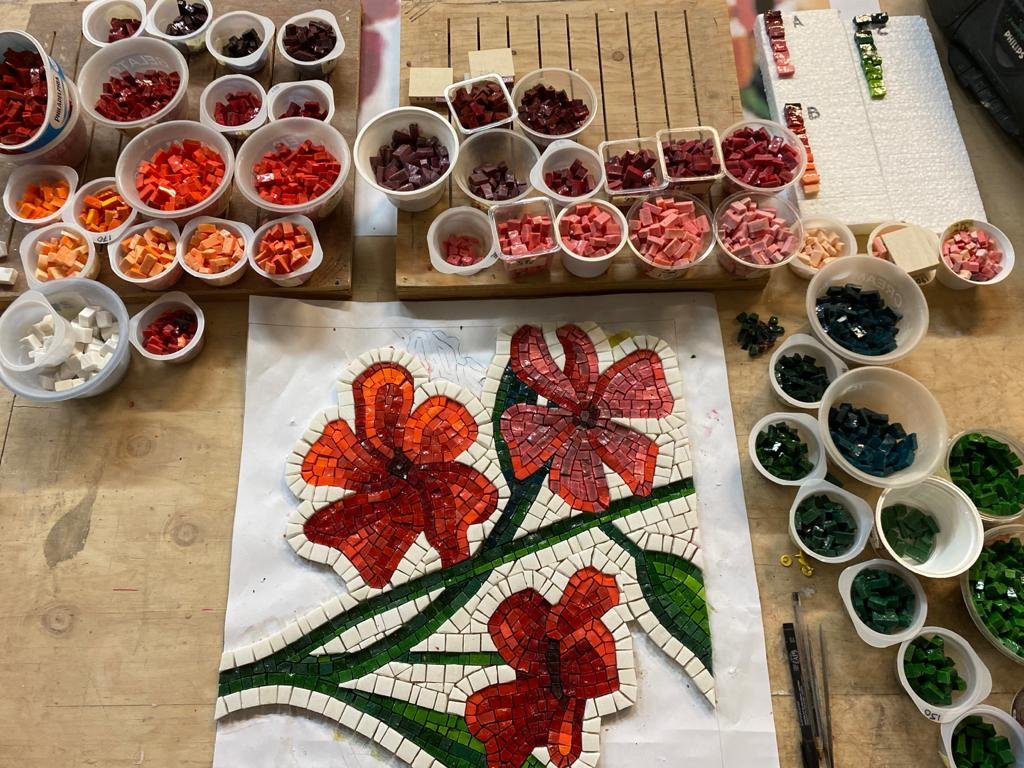VIAGGIO TRA I PROTAGONISTI DEL MOSAICO Journey among the protagonists of the mosaic
Tell us in short your path, from your formation to today and in particular how you discovered and how you approached the art of mosaic. I studied art history and foreign language (German and Italian) during university. When I graduated, I earned a Rotary International Foundation Scholarship to the art faculty at Universitá degli Studi di Perugia. I spent a year there attending classes, and became fairly fluent in Italian. After I was married, I took a trip to the Metropolitan Museum of Art in New York. For some reason, even though I had seen countless Cosmati and mosaic floors in Italy and Greece, the polychrome sea monsters in NYC made me want to experiment with mosaics. I asked a friend to help me, and soon we had a commission from a friend to make a bathroom mosaic floor. We had no place to train, so we bought a book and a wet saw and started cutting marble scraps. After that, it was “word of mouth” and a little local, then national publicity. Because we didn’t have mosaic schools in the US in the early 1990s, I took courses and workshops wherever I could, both in the US and in Italy. It wasn’t the traditional way to learn, but each time I wanted to create a mosaic in a different material or technique, I would seek out the best instructor for that method. Gradually, I developed a capacity to work in stone, smalti and other materials.
Among the various art forms and techniques, why did you choose to dedicate yourself to mosaics? I love the tactile process of building the andamento, filling in the surface. And the materials are so fundamental, from a chemical and visual (color) sense. Working with earthly materials, something so ordinary such as stones from a river, is a challenge. You must plan, sort, cut, and literally “bend” the materials to make them behave the way you intend. When an artist re-imagines these materials and creates something totally new, there is a satisfaction in having made something new and beautiful.
In your opinion, what should be the fundamental characteristic of a good mosaicist? Patience! At least that’s what everyone on the outside thinks. How many times does a mosaicist hear someone say, “Oh, I would never have the patience to do such work.” I think it’s very true, even if it’s not the only characteristic. There is patience required to do the essential planning of the project. It’s not the sexy part: measuring, drawing, correcting, dividing the bozzetto and the substrate, and preparing the tesserae. We organize our colors and we just want to start gluing!
Also, I think you must have a strong color sense, because the use and, equally, the restraint of color are so important. Composition skills are essential, too. If a mosaicist is only attracted to using beautiful colors, but has no sense of how to compose the design, the work won’t be pleasing.
What is mosaic to you, and what does it mean to be a mosaicist? For me, the most fundamental idea that comes to mind in “being a mosaicist” is the community of extraordinarily talented artists that become part of your mosaicist family. Through workshops, tours, and international conferences and symposia, I have had the great fortune to meet so many mosaic artists and industry professionals. We share the same passions and intensity. It is so invigorating to be a part of that network.
What is your source of inspiration? Inspiration comes in many ways. If I am doing a commission for a client, there are always ideas and requirements that will dictate the subject matter and the materials. I don’t mind that. It invites me to create a mosaic I otherwise wouldn’t have made. In my own work, I try to create mosaics that bring awareness of the environment and humanity’s effect on it. Nature can be beautiful and destructive simultaneously. What we do to the Earth has so many effects, and people act as if “Mother Nature” is the one out of control. Often when I’m working on my own sculptures, there are world events happening that strongly influence my choice of color and surface. Fires, hurricanes, tornadoes - it’s all in my work!
What materials do you prefer?Smalti and stone are my two favorites, often used together.
Among the various art forms and techniques, why did you choose to dedicate yourself to the mosaic? I can’t say exactly. I originally meant to be a commercial or interior designer. I made mosaics as a hobby first, then built it into a full-time job. I recognize the same spontaneous reaction in many beginning mosaic artists: we have an “aha” moment and realize we love mosaic-making more than drawing, painting, or caring for our young children (kidding!).
What does the mosaic represent for you? E What does it mean to be a mosaicist today? Today, for me, being a mosaicist is being a disciplined businesswoman. As much as I would like to go to the studio every day and place tesserae, I haven’t been in there for a month (Partly due to COVID-19 restrictions). Instead I am researching, drawing, emailing the clients, calculating prices, editing contracts, calling my insurance agent about liability certificates, and worrying about the cost of shipping a project from Mexico to Texas. To be a mosaicist today is to be a multi-tasker. Oh, and I’ve been neglecting my website and Instagram…If we are a small company with no partners, we have to wear all the hats. Sometimes that is the biggest challenge.
Mosaic art has a rich and fascinating history. Are there some artists from the past that you find particularly inspiring in your work? Why? There are so many artists of the past whose work I adore. But the artists I respect the most are those individuals and mosaic companies who are today creating new and glorious mosaics that show the public what modern mosaic can be. I especially admire the artisans who can take a design from an artist who is NOT a mosaicist, and improve it by using all the skills inherent in the mosaic-maker’s repertoire. In every case, the mosaic itself is so much more vibrant and engaging than the original. And that, to me, is special about mosaic.
Is there a contemporary artist with whom you are connected and collaborate with? Yes. I work with several wonderful artists. Some are mosaicists, like Lynne Chinn and Ana Foncerrada. Others I’m currently working with are part of my design team - I love the mosaic-making, but I prefer to collaborate on the design portion of a large commission when it’s possible. Three of my current commissions allow me to work with some really talented painters and sculptors, who will execute the design ideas we discuss. Then I’ll interpret them into mosaic.
What is the message implicit in your works, what do you want to communicate? Certainly a sense of timelessness - of the materials themselves and of the art of mosaic. I hope that my work expresses a level of quality, or determination to do my best work, which shows a respect for both medium and viewer.
For you, does mosaic represent ongoing research? New techniques, new solutions? Oh, yes. It often seems like each new commission requires me to re-invent my methods! Each job has its own requirements and restrictions. I appreciate the innovations in mortars, substrates and technology. I confess I would rather adhere my mosaic to a Schluter panel with an aluminum cleat, rather than use the ancient methods with lime and cloth. Perhaps my works aren’t as classical as a Roman mosaic, but they suit their purpose for the clients.
Tell us about your latest work. The last work I completed was a small (20 x 20 cm) butterfly in smalti for a friend’s mother’s birthday. But coming up, I have four commercial projects and I’m a little stressed about which one will go into production first: a fire station mural near Dallas, a pavement and sculpture for a hotel in Fort Worth, Texas, a series of interactive elements for a new animal adoption center, and a restaurant/hotel in Dallas. The life of an artist is feast or famine; 2019 was quite slow. 2020, not so much!
What makes your work unique? Is there one of which you’re particularly fond? I don’t think I have a recognizable style, because much of my work is commission-based and therefore conforms to the client’s needs. A friend says she can recognize my andamento, though! I think my favorite piece is La Corrente, a white mosaic dress covered in sea spines and green gold smalti sea kelp. I made it during a tragic oil spill in the Gulf of Mexico. To me it represents purity and grief for the loss of clean oceans.
What achievement are you most proud of? The Orsoni Prize in 2009 was a highlight for me. It was an honor to have my work displayed in Venice, and the generous award that included a week at Orsoni was great fun. The staff have become good friends.
What inspires you creatively? I am most productive when I’m given a challenge, whether that’s from a client, or a call to work in a theme, such as the mosaic symposium in Ploaghe, Sardinia. Museums and travel are good sources.
What impression do you try to stir on those who observe your works? I would most like to provoke people’s curiosity - in the methods, materials and process required to make the work. If you see a viewer lean closer and reach out to touch your work, they have engaged in a discourse with you and your work.
What would you recommend to young people who would like to approach the art of mosaic? I would urge them to get as much training and experience as they can. Because I didn’t have the benefit of attending a true mosaic institute, I often feel like I have “missing skills” in my mosaic tool box. I’m sure I often end up doing things the wrong way - but hopefully still yielding a nice result.
Many thanks to Francesca and Debora! ~ Julie













